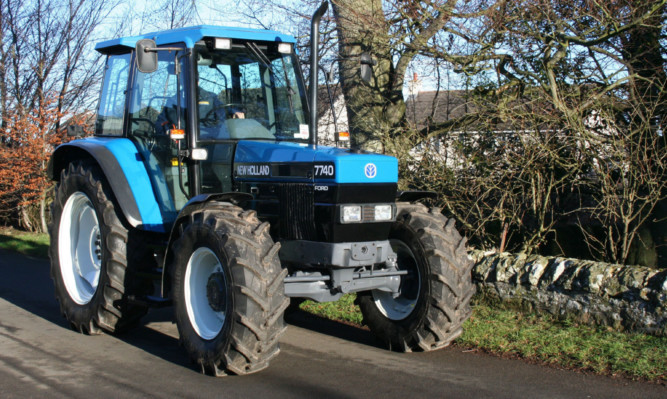Today New Holland is a full-line brand with healthy sales across most territories, and many innovative features and technologies supported by dedicated dealer networks and back-up.
The origins are complex, but the family tree makes for an interesting story.
Italian automotive giant Fiat bought out Ford New Holland in 1991 as the US firm divested its agricultural and construction side to concentrate on automobiles worldwide.
Ford had bought New Holland from the Sperry Corporation in October 1985. It was looking to become a full-line concern like most of its competitors, who offered not just tractors but forage and harvesting machinery.
Ford and New Holland had strong ties, with Ford engines used in the combines and forage harvesters, and many Ford dealers also selling New Holland products.
As part of Fiat’s purchase agreement it was to relinquish the Ford oval logo by May 1995. It had to find a common branding between the two very strong products and keep customers sweet on either side of the Atlantic.
Fiatagri would favour one half of the new concern, while FiatGeotech and NHGeotech were not very catchy. Other brands in the portfolio were Hesston, Braud, Laverda, Agrifull and Versatile, but these were deemed unsuitable as they were regarded as specialist.
An invented name was also discounted, leaving New Holland as the likely candidate. This made sense as New Holland had originated in Pennsylvania and was highly regarded in the States, but was also well known in Europe for its grassland equipment, balers and combine harvesters.
The choice of logo saw Fiat’s leaf retained but the colour changed from terracotta to blue.
The Ford and Fiat names remained on tractors alongside New Holland until 1998, when they were phased out.
For a while tractors of either of the former lines could be turned out in Fiat’s terracotta colour scheme or the blue of Ford.
Many loyal Spanish and Italian buyers of Fiat tractors were unhappy with the new name, and dealers were sold out of Fiat decals very quickly as they wanted to keep the Fiat brand alive on any new tractors.
Incidentally, the Fiat leaf logo was developed in 1983 when Fiatagri was formed to encompass the Fiat tractor, Laverda combine and Hesston forage machinery ranges under one name. The symbol represented a sign of growth and also resembled a tyre print in the soil.
Many British farmers were familiar with the New Holland brand long before Ford came along. The yellow combines bearing the name had long been popular, as had the red and yellow balers, forage harvesters mowers and tedders.
The origin of the yellow combines dates to 1906, when Belgian Blacksmith Leon Claeys started building his own threshing mills in Zedelgem. He moved on to build straw trussers, flax harvesters, engines and elevators.
In 1946 he turned his attention to trailed combine harvesters and in 1952 launched the MZ model the first European-built self-propelled combine.
These combines came over to the UK in a reddish-orange colour scheme and were marketed by Blanch until Bamford of Uttoxeter became UK importers in 1958.
Bamford lost out in 1964 when Claeys was bought out by New Holland’s owners the Sperry Rand Corporation. By this time the combines were branded as Clayson because it was a better title in some areas and created a stronger distinction from European rival Claas.
With the takeover, the New Holland name also appeared on combines.
Today both the Claeys and Clayson names have disappeared.
Prior to this period New Holland had opened a marketing and manufacturing facility at Stroud in Gloucestershire in 1954, before moving to a new factory at Aylesbury in Buckinghamshire in 1956. The American-designed Model 66 baler was the first product to be built.
New Holland’s own origins date to 1895, when machinist Abram Zimmerman opened a repair shop in New Holland, Pennsylvania.
By the turn of the century he was turning out feed and cob mills and his own stationary engines to drive them.
In May 1903 the business was incorporated to become the New Holland Machine Company and moved to purpose-built premises next to a railway line.
Zimmerman left in 1914 but the company continued to prosper and added feed-processing machines, stone crushers and quarry equipment.
The Great Depression had the firm at the brink of bankruptcy, but a new management team saw the company flourish through the 1940s with innovative machines.
One machine which helped turn New Holland around was the Automaton baler the first commercially successful automatic pick-up and self-tying baler.
The machine, invented by Ed Nolt, differed from others in that it held the bale in compression when it was tied with twine as opposed to wire.
Some reached Britain during the Second World War under lend-lease and were ideal for the bouts of straw left behind by the new combines.
New Holland was put on a sounder footing in 1947 when it became part of the Sperry Rand Corporation.
In 1949 it launched the very successful Model 77 baler, a high-capacity machine which was smaller and lighter than any of the other makes on the market.
Further products offered in the late 1940s included forage harvesters, side delivery rakes and dung spreaders.
Factories were opened at other sites in Pennsylvania at Belleville, Mountville and Lancaster.
More machines and further innovation continued during the 1950s, with the Model 800 forage harvester with a cylinder cutting head and self-sharpening blades.
The self-propelled Model 166 baler also arrived at this time.
The 1960s saw new grinder-mixers, mower-conditioners, silage chopper-blowers and forage wagons. There was the revolutionary Speedrower self-propelled Windrower and the ground-breaking but complex and expensive Automatic Bale Wagon. Self-propelled forage harvesters were also introduced.
With the parent company buying Claeys of Belgium, a successful range of combine harvesters was added to the extensive line.
New Holland is a worthy name to adorn a range of tractors with a proud heritage.
